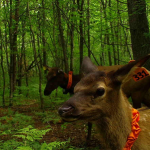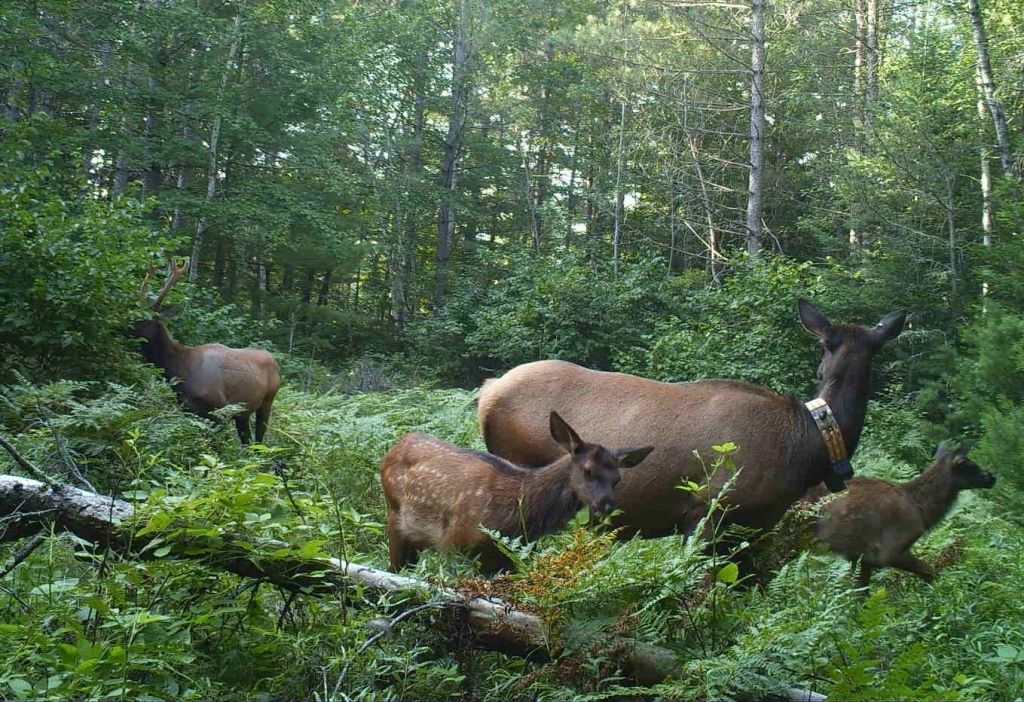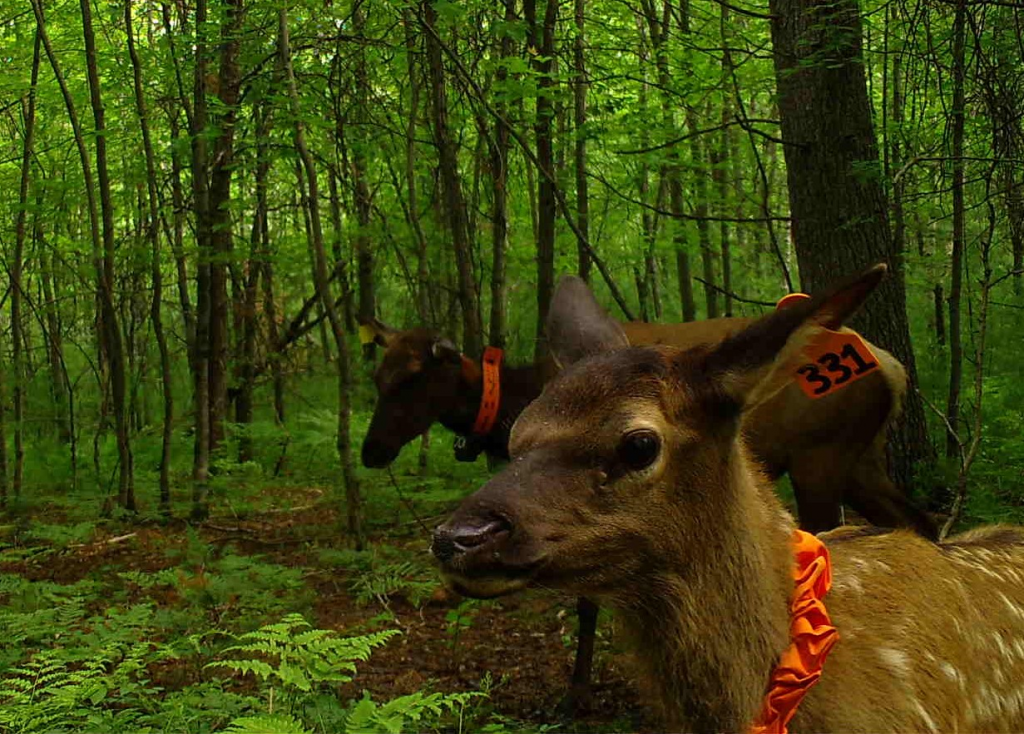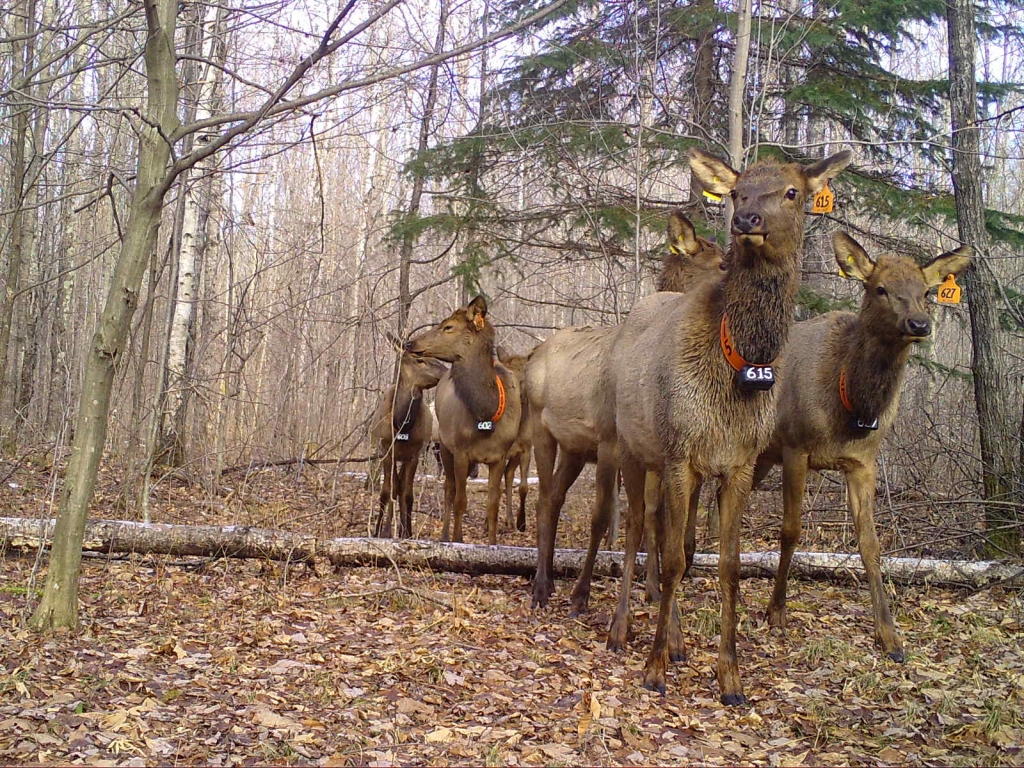Snapshot Wisconsin February 2021
Members of the Snapshot Wisconsin team are busy compiling a dataset of all the elk photos from the previous calendar year, 2020. This dataset feeds into models that estimate how many elk live in our state and is an important way Snapshot contributes to the state’s natural resources.
For this edition of the newsletter, the team highlights two important collaborators whose work directly uses the elk dataset. Both of these collaborators work in the same office that houses Snapshot Wisconsin, the Office of Applied Science, and their collaborations with Snapshot are great examples of how integrated Snapshot data is into the DNR.
Those interested in discovering yet another way Snapshot data impacts wildlife management should buckle up as we dive into our collaborators’ work.
Elk Snapshots Mean Better Elk Modeling
Jennifer Price Tack is the Large Carnivore and Elk Research Scientist within the Office of Applied Science. In this article, Price Tack shares how she uses Snapshot data to improve Wisconsin’s annual elk population estimate. Price Tack also talks about how looking at the data from Snapshot photos tells us important information about the health of the elk herds.
Individuals matter too! – When you can ID them
Glenn Stauffer, Natural Resource Research Scientist within the Office of Applied Science, discusses how he leverages the power of identifying individual elk to better improve upon the annual elk population estimate. Stauffer also shares surprising ways that information can be extracted from a single photo, beyond just what animals are present in the photo.
Elk Snapshots Mean Better Elk Modeling
At the start of every year, DNR staff begin compiling a large dataset of elk sightings from the previous calendar year, and the data, once compiled, is used to calculate the total number of elk that live in the state. This method has been a standard practice since the second reintroduction of elk to Wisconsin.
What some of you may not know is that Snapshot plays an important role in counting elk by providing sightings, particularly of bulls. In fact, Snapshot has more than 250 of its cameras (over 10% of all Snapshot cameras) dedicated to monitoring elk alone. These cameras are clustered in the three areas of the state with part of the elk herd - Clam Lake, Flambeau River and Black River Falls. These elk cameras are arranged into a grid-like pattern in each area, just like the rest of the Snapshot grid, except that the density of cameras in the elk grid is a lot higher.
A few members of the Snapshot team are among those working on the 2020 elk dataset, so the team decided to focus this newsletter on elk and how they use photos to learn about the elk herd.
The Snapshot team invited Dr. Jennifer Price Tack, Large Carnivore and Elk Research Scientist and fellow scientist within the Office of Applied Science, to add her perspective to this newsletter on why Snapshot’s photos matter for elk.
The task of integrating Snapshot data into the elk model was originally the work of Joe Dittrich, who laid a solid foundation for Price Tack. Since Price Tack joined the Office of Applied Science at the end of 2019, she has been using Snapshot data to model how various quota alternatives will affect the elk herd size in the years to come.
“My research focuses on [elk] populations because populations are the scale at which we manage wildlife,” said Price Tack. Population is the starting point for all decisions that are made about managing wildlife in Wisconsin. The status of a population determines how decisions are made, policy is framed, quotas are set, permits are allocated, and so on… Population is the unit of concern for the DNR.
Price Tack continued, “While individual animals are important and make up a population, our ability to manage them breaks down some at the individual level, [simply] due to the infeasibility of monitoring individuals.”
For species like elk, which normally lack easy-to-identify markings, individual identification is often difficult. Possible, as discussed in the next article, but difficult. Thus, populations tend to be the scale of most species work at the DNR, including Price Tack’s work on elk.
As Price Tack walks us through her research on the elk population, check out the unique way that Snapshot photo data are used to monitor this large herbivore population.
Feeding photo data into the model
Photos of elk can have multiple forms of data in them, beyond just what animals are present in the picture. There is camera location data, for example, which provides information about which areas of land the elk are using and not using.
There is also movement data. The Snapshot team learned that elk calves, cows and bulls have different movement patterns and are seen at different rates throughout the year. When bulls are the most active, for example, cows tend to be less active.
The camera data also helps Snapshot determine a calf-to-cow ratio for elk. Although, it isn’t as simple as dividing all the calf photos by the number of cow photos. Cows move around more than calves do and are more detectable in photos, given their larger size. Using knowledge about calf/cow visibility, calves and cows are modeled separately, and those numbers are then used to calculate the calf-cow ratio for elk.
“I remember first learning about Snapshot and thinking it is such a cool resource! There is so much you can do with camera data.” said Price Tack. “I have experience working in other systems that use camera data, so I know [firsthand] that using camera data has a lot of benefits” - benefits like providing many forms of data at once and being more cost-effective than extensive collaring. “I wanted to tap in and work with these folks.”
Price Tack mentioned that she even had the Snapshot logo in her interview presentation. She was already thinking about how to get the most out of Snapshot’s camera data.
“Now that I’m here, my focus is on filling research needs to inform decisions,” Price Tack continued. “[Our research] is going to be critical to helping wildlife management and species committees make informed decisions for elk, such as deciding elk harvest quotas in the upcoming years. Snapshot data is one tool we can use to fill those research needs. It is available, and I’d like to use it as much as feasible.”
Besides estimating the population of the elk classes (e.g. calves, cows and bulls), Snapshot data is currently being used to help estimate population parameters and help us understand what is happening with the population. Population parameters are estimates of important characteristics of the population, such as recruitment (birth rate), mortality (death rate) and survival rates of different elk classes within the population.
Price Tack’s model uses matrix algebra to take an initial elk population size and projects the population into the future, using what we know about elk population parameters. In other words, the model can predict how large the elk population is likely to grow in the years to come. There is natural variation however, that can cause some years to be unpredictably good or bad for elk, so the model needs to be updated each year to keep its accuracy as high as possible.
Thanks to Snapshot’s camera data, we have a system in place to calculate each year’s population parameters and continue updating the model each year. This should help us catch if anything of concern happens to the population and (hopefully) fix it before it becomes a threat.
Improving the Elk Model
Another of Price Tack’s tasks related to Snapshot is improving the elk model. Many of the improvements Price Tack is researching aim to address data collection for a larger population.
The elk population was very small when the DNR first reintroduced elk to the state in 1995 and again in 2015. The DNR used intensive monitoring methods back then to collar (and track) every elk in the herd, since intensive methods are best suited for small populations. However,with the elk herd doing so well, it won’t be long before a different approach is needed. The DNR wants to transition to a method more appropriate for a larger elk population.
Currently, the DNR is early in the process of ramping up non-invasive, cost-effective methods like Snapshot monitoring and toning down the collaring effort. Although, this transition will take time, happening over the next few years.
Price Tack also mentioned another modification under consideration. Price Tack and the Snapshot team are looking into repositioning some of the cameras within the elk grid. Currently, the elk grid doesn’t perfectly align with where the elk are congregating. There are a few cameras outside of the elk range that don’t see any elk, and there are edges of the elk’s range that extend beyond where the cameras are deployed. Repositioning the cameras should mean more elk pictures, which means more elk data.
The Frontier of Camera Monitoring
The role of Snapshot in monitoring elk is evolving, and Price Tack and the Snapshot team believe it is for the better. While they can’t guarantee that Snapshot will always play a central role in collecting data on elk, Snapshot will fill this role for the next few years at least.
Price Tack said, “This is the frontier of using camera trap data for elk. Every year, new approaches to using camera trap data are being developed. That has me excited that, even though we don’t have all the answers now, more opportunities may be on the horizon.”
Continue reading the next article for more on elk research in Wisconsin. You can also get more elk-related news by signing up for the Elk in Wisconsin topic on GovDelivery. Joining this email list (or others like it, including a GovDelivery topic for Snapshot Wisconsin) is the best way to make sure you don’t miss out on news you are interested in.
Individuals matter too! – When you can ID them
Elk are similar to deer in that they lack identifiable markings most of the time. This makes it hard to know whether an elk in one photo is the same elk that appears in another photo. However, some elk in Wisconsin have uniquely numbered collars, making it possible to identify one individual elk from another.
Using these collars, researchers can piece together all the Snapshot photos of that elk and follow its movement through time. Knowing that the elk in two different photos is the same individual holds a special type of power for researchers and tells them extra information about the size of the elk herd. That is, if the researchers can leverage that additional information.
Glenn Stauffer, Natural Resources Research Scientist within the Office of Applied Science, is leading the initiative to identify individual elk and use these data to improve the annual elk population estimate. Stauffer said, “I was approached because of my quantitative modeling experience to evaluate different ways of using the elk photographs as data to fit an elk model. [Collectively,] the various models I and others have worked on provide a range of options to estimate the [elk] population size and to evaluate how reliable the models are.”
Identifying Individuals
To better understand the significance of Stauffer’s work, it helps to know how elk have historically been counted in Wisconsin.
“Long before I came onto the scene, the primary way of counting elk was to go out and count them all,” said Stauffer. This method requires extensive time in the field and considerable local knowledge about where elk groups often hang out. Researchers could count some elk by their numbered collars, but they also needed to know how many uncollared elk were in each group. The elk herd grew over the years, and more and more elk did not have identifiable collars. This added another challenge for researchers who were trying to count all the unmarked elk (and make sure they weren’t double counting any of them).
Since the estimate of the elk population size still needed to include an unknown number of these unmarked individuals, the DNR started experimenting with models that didn’t require individual identifications. These new models were also a boon because the herd was reaching too large a size to efficiently collar. It was becoming too much of a time investment and was expensive.
Instead, these models are based on images from the Snapshot camera grid, as discussed in the previous article, but even these camera-based models had room for improvement. Thus, Stauffer began researching a model that incorporated the best of both approaches: a model that was based on the camera data but still incorporated limited individual identification back into the model.
Stauffer’s Model
Stauffer looked into a variety of models but zeroed in on one type of model in particular. Stauffer explained that this model belongs to a class of models called spatial mark resight models. Spatial mark resight models combine the best of both marked and unmarked models. Stauffer’s model identifies individuals by their collars but also makes inferences from the photos of unmarked elk at the same time.
Spatial mark resight models also relax a major assumption made by the previous camera model, the closure assumption. “This assumption states that the number of elk at a particular camera location doesn’t change from one encounter occasion to the next, and it is clearly violated. Elk are wandering from camera to camera,” said Stauffer. Stauffer’s hybrid model relaxes the closure assumption and attempts to figure out the minimum number of distinct elk it can identify from the pictures.
Collared elk are often easy to identify in the photos. These collared elk are given the ID assigned to their respective collar number so that all photos of a particular elk share the same ID. The model also attempts to assign IDs to uncollared elk in the photos. The model uses probabilistics to assigns IDs to all remaining elk - either uncollared elk or unknown elk (because the collar or the collar number isn’t visible in the photo) - based on characteristics visible in each photo.
Fortunately, Stauffer’s model uses as much information as it can get from the photos when assigning IDs. For example, if one photo is of a calf and another photo is of a cow, then the model won’t assign the same ID to these animals. After all, we know those are two distinct elk, not one. Similarly, a marked but unidentified elk with one collar type can’t be the same as another unidentified elk with a different collar type. The model even uses spatial data to differentiate unmarked elk from two different photos. For example, photos at two locations close together might be from the same elk, but photos from two distant locations probably represent two different elk.
Capitalizing on all the information available in the Snapshot photos, the model makes an estimate of how many elk are likely in Wisconsin’s elk herds. As the elk herds continue to grow, this modeling approach helps estimate the elk population and hopefully saves the DNR time and money.
How well does the model work?
“[Technically,] the spatial count model doesn’t require any information about individual IDs, but it performs pretty poorly without them,” said Stauffer. “There is a series of papers from about 2013 on that shows if you add information about individuals to spatial counts, you can really improve the accuracy and precision of the spatial model.”
“Theoretically, this makes the model estimates more precise,” said Stauffer. To check, Stauffer collaborated with a colleague to run a bunch of simulations with known, perfect data, and the model worked reasonably well. These simulation results are encouraging because the model wasn’t massively overpredicting or underpredicting the number of elk in the herds, both of which could have management implications for elk.
When asked if identifying individuals from photographs is worth the extra effort, Stauffer said, “Working with models that don’t require individual IDs still requires considerable time to classify photos. Identifying individuals is only a little bit more work on top of that. In general, when you can’t meet the assumptions of a model, then it is worth getting individual identifications, if you can.”
Just how much additional effort should be put into individual IDs? Stauffer believes part of the answer comes from asking what other information can be obtained from the collars. “If we are already putting the collars on those we capture or release, then we might as well get as much out of them as possible, such as through using photographs [like Snapshot does],” said Stauffer.
Incorporating Another Year
After the Snapshot team finishes assembling the 2020 elk dataset, a large dataset comprised of the data from all the Snapshot photos of elk in 2020, Stauffer will run his model using this new dataset and generate an estimate of last year’s final elk population. Stauffer’s estimate will be closely compared to other estimates generated by the previous camera-based models and through collaring efforts alone to see how well each approach performs.
Stauffer took a minute to reflect on his work so far with the elk population estimate. Stauffer said, “The modeling process has been really rewarding, diving into this topic in a depth that I would not have done if I did not have this Snapshot photo dataset to work with. The simulation also went well. It illustrated that the model works the way we claim it works, which is good. Fitting the model to the elk data is mostly encouraging, but it shows that there are situations where it doesn’t do as good of a job as we hoped. Specifically, for calves, it still needs to be fine-tuned.”
From physically counting elk to modeling counts of only unknown individuals to modeling counts of both unknown and known individuals, Wisconsin’s approach to estimating elk abundance has evolved through time. Chances are, as the composition and distribution of the herd changes in the coming years, the approach will evolve even more. But for the next few years, Stauffer’s work will help direct how we count elk now.











